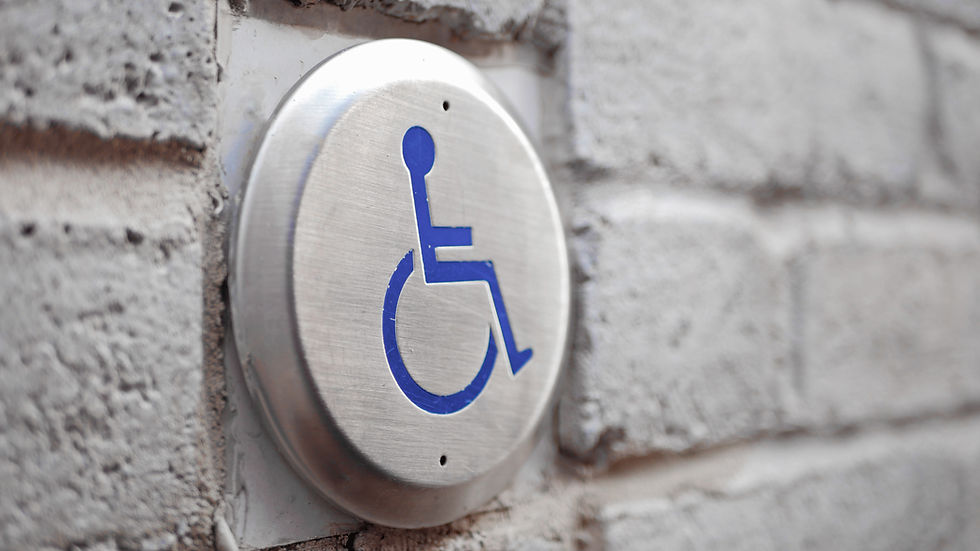The 2022 Global Report on Assistive Technology and Where the U.S. Currently Stands
- Sam Shepherd
- Jun 5
- 6 min read
Introduction
In 2022, the Global Cooperation on Assistive Technology (GATE), an initiative under the World Health Organization (WHO), released a global report on assistive technology. Much of this report is for countries that are working towards developing assistive technology related policies and provisions, but there are still ways in which the United States can improve the policies, provisions, etc. regarding assistive technology. This report provides information on many areas within assistive technology, as chaptered here [1]:
Understanding assistive technology
Measuring access to assistive technology
Identifying barriers to assistive technology
Improving the assistive technology system
Preparing for assistive technology in humanitarian crises
Creating enabling environments
This article will go through the 10 recommendations featured at the end of the report (beginning on page 102), which include context for the importance of each recommendation based on the report at-length. This article will also discuss how each recommendation pertains to what we’re currently doing in the United States as well as what we need to do better.
Recommendation 1: Improve access to assistive technology within all key development sectors.
Included areas within the report are education, labor and social services, as they are all essential parts of daily life where assistive technology (AT) is needed [1]. The report also lists out key stakeholders as government, private sector, NGO’s, and (most importantly) groups representing AT users and their families. Moving forward, Education law in the United States guarantees the rights to access assistive technology and related services, specifically through the Individuals with Disabilities Education Act (IDEA) reauthorization of 2004 [2]. Although it is required under law, research indicates that it is not fully implemented, meaning that a lot of students who need AT are simply not receiving it [3].
As for the workplace, general accommodations are meant to be met under the Americans with Disabilities Act (ADA). Under this same law, you may be able to receive assistive technology if necessary for your job [4]. For social services in the United States, there are only 31 states (and DC) that provide AT through medicaid waivers for individuals with disabilities, as of 2021 [5]. In more depth, each state, DC, and the 5 US territories have their own assistive technology program, which supports meeting AT needs, discounted or refurbished devices, loans, trials, and more; all of which was made originally under the AT Act of 1988, but has since been reauthorized multiple times [6].
Recommendation 2: Ensure that assistive products are safe, effective and affordable.
The report included the following points when discussing this recommendation [1]:
cost-minimizing designs
manufacturing
business models and service delivery
reduced taxes and duties on assistive products and required materials
effective procurement processes
health and social insurance coverage or other cost-reducing programs
The rise of low tech assistive technology solutions can certainly support cost-minimizing designs, as well as open source platforms for 3D modeled AT, but is not the end all solution. Many assistive technology products are manufactured in the United States, such as SP AbleWear [7]. Continuing, as for Health and social insurance, both are addressed in the previous recommendation when discussing social services; but to add, the AT programs received $311 Million from 2014-2024 and resulted in a $732 Million return on investment, continuously proving to be a cost effective way of getting assistive technology to the people that need it [8].
Recommendation 3: Enlarge, diversify and improve workforce capacity.
The report lists out groups that need to learn more about AT to improve overall access to AT. The list includes nurses, community-based rehabilitation workers, and obviously assistive technology professionals too; yet the report wanted it to have a broader scope of knowledge than just assistive technology professionals [1].
In the United States, there is an increased need for more assistive technology specialists as well as more assistive technology programs at universities, with less than 30 in the country [9,10]. Not only are there assistive technology specialists involved in assistive technology, but roles such as occupational or physical therapists, speech language pathologists, and special education teachers or paraprofessionals should have training and understanding in assistive technology.
Recommendation 4: Actively involve users of assistive technology and their families.
Person centered approach not only applies to the individual and their assistive technology needs, but for the advancement of assistive technology development as a whole. This also needs to include their family members and those closest to them. As the report includes multiple times, the users of the assistive technologies are “not passive service recipients,” but rather providing input on the devices they use or try out. This is what is already encouraged in the United States as well, including Technology First.
Recommendation 5: Increase public awareness and combat stigma.
The report states “Ensure policy-makers are aware of the need for – and benefit of – assistive technology, including its return on investment [1].” As for the United States, this recommendation mirrors the point from Recommendations 1 and 2 in regards to the Assistive Technology Act, which has educated numerous Congresses since it has been reauthorized multiple times since its origin in 1988. To add, the Association for Assistive Technology Act Programs (ATAP) and The Center for Assistive Technology Act Data Assistance (CATADA) each provides data on the return on investment for the AT Act funding. However, the United States still has room to grow in public awareness of assistive technology, and thus removing stigmas.
Recommendation 6: Invest in data and evidence-based policy.
The report builds off of Recommendation 5 as it seeks countries to have data on various areas of assistive technology, such as the supply and demand, and have population related data as well. Referring again to the last recommendation, the two programs mentioned in Recommendation 5 best fit what the United States does for this recommendation too.
Recommendation 7: Invest in research, innovation and an enabling ecosystem.
The report states “It is essential to link users, researchers, innovators, universities and industries within and between countries, providing mutual learning, research and innovation opportunities” and in a person centred approach [1]. In the United States, there is RESNA and the Assistive Technology Industry Association (ATIA), both being membership-based organizations that include AT companies and organizations, with RESNA focusing more on education and accreditation and ATIA focusing on the industry at large. There are also many universities around the country that have labs, projects, or centers dedicated to assistive technology research and innovation, such as the Miami University Center for Assistive Technology or the Center for Inclusive Design and Innovation.
Recommendation 8: Develop and invest in enabling environments.
Investing in enabling environments is emphasized greatly in the report, as it should be made possible through policy and programs [1]. The United States has the Americans with Disabilities Act from 1990 that still helps ensure accessibility [11]. While this has been law for 35 years, gaps still remain in accessibility for many with disabilities.
Recommendation 9: Include assistive technology in humanitarian responses.
The report details the vital importance of having assistive technology systems in place when a humanitarian crisis takes place, including the provision and the access to AT [1]. There is alot of work that needs to be done in the United States in regards to in humanitarian responses from a board perspective as well as AT specifically, including the recent wildfires in California [12].
Recommendation 10: Provide technical and economic assistance through international cooperation to support national efforts.
The last recommendation of the report discusses the need for international cooperation and support through economic, research, development, and other solutions to improve assistive technology outcomes globally. USAID has helped support global assistive technology initiatives, such as helping fund ATscale, an organization working towards global access to assistive technology [13].
Conclusion
While the United States is farther ahead most, if not all of, the world in assistive technology and the recommendations set by the WHO, there are opportunities for us to grow in each of the recommendations to ensure that every individual with an assistive technology need can have their needs met in a swift process, with the policies, provisions, products, and personnel to do so. There will also be a report coming in 2026, where we can be updated further on assistive technology at the global scale, and from there, see what additional approaches are applicable to the United States.
Sources
[1] World Health Organization , 2022, Global Report on Assistive Technology , https://iris.who.int/bitstream/handle/10665/354357/9789240049451-eng.pdf?sequence=1.
[2] Federal Legislation and Assistive Technology, ataem.org/storage/ocali-ims-sites/ocali-ims-ataem/documents/AT_Resource_Guide_2.pdf. Accessed 5 June 2025.
[3] “How Many Schools Provide Assistive or Adaptive Technology for Students with Disabilities?” How Many Schools Provide Assistive or Adaptive Technology for Students with Disabilities? | AccessComputing, www.washington.edu/accesscomputing/how-many-schools-provide-assistive-or-adaptive-technology-students-disabilities. Accessed 5 June 2025.
[4] Liebs, Andrew. “Ten Ways to Fund Assistive Technology Purchases.” Western University of Health Sciences, Harris Family Center for Disability and Health Policy, www.westernu.edu/mediafiles/cdihp/assistive-technology-funding-sources.pdf. Accessed 5 June 2025.
[5] Friedman, Carli. “Assistive technology for people with intellectual and developmental disabilities in the United States in home- and community-based services.” Disability and Rehabilitation: Assistive Technology, vol. 19, no. 6, 20 Oct. 2023, pp. 2213–2220, https://doi.org/10.1080/17483107.2023.2272849.
[6] History of at Act PDF, Association of Assistive Technology Act Programs, ataporg.org/wp-content/uploads/docs/at-act-info/21st-century-at-act/history-of-at-act.pdf. Accessed 5 June 2025.
[7] Maddak, SP Ableware/. “Supreme Sock Aid from SP Ableware/Maddak Increases Independence and Restores Dignity.” Supreme Sock Aid from SP Ableware/Maddak Increases Independence and Restores Dignity, 11 Sept. 2023, www.prweb.com/releases/supreme_sock_aid_from_sp_ableware_maddak_increases_independence_and_restores_dignity/prweb13285094.htm#.
[8] “Home.” ATAP, 4 June 2025, ataporg.org/.
[9] “New and Emerging Careers in Education: American University.” School of Education Online, 5 Feb. 2025, soeonline.american.edu/blog/exploring-cutting-edge-careers-in-education/#:~:text=certified%20behavior%20analyst.-,Assistive%20Technology%20Specialist,careers%20and%20earning%20higher%20salaries.
[10] “University Programs.” RESNA, www.resna.org/Resources/University-Programs. Accessed 5 June 2025.
[11] “The Americans with Disabilities Act.” ADA.Gov, www.ada.gov/. Accessed 5 June 2025.
[12] Popkin, Susan J., and Dulce Gonzalez. “The Los Angeles Wildfires Pose Great Health and Housing Risks, Especially for People with Disabilities.” Urban Institute, 23 Jan. 2025, www.urban.org/urban-wire/los-angeles-wildfires-pose-great-health-and-housing-risks-especially-people-disabilities.
[13] 2023, ATscale , https://static1.squarespace.com/static/5b3f6ff1710699a7ebb64495/t/661d28cef7610f25abd534fe/1713187035976/Annual++Review+2023.pdf.



